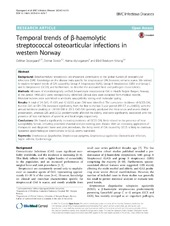Temporal trends of β-haemolytic streptococcal osteoarticular infections in western Norway
Peer reviewed, Journal article
Published version

Åpne
Permanent lenke
https://hdl.handle.net/1956/16249Utgivelsesdato
2016-10-04Metadata
Vis full innførselSamlinger
Originalversjon
https://doi.org/10.1186/s12879-016-1874-7Sammendrag
Background: Beta-haemolytic streptococci are important contributors to the global burden of osteoarticular infections (OAI). Knowledge on the disease traits specific for streptococcal OAI, however, remains scarce. We wished to explore temporal trends of OAI caused by Group A Streptococci (GAS), Group B Streptococci (GBS) and Group C and G Streptococci (GCGS), and furthermore, to describe the associated host and pathogen characteristics. Methods: All cases of microbiologically verified β-haemolytic streptococcal OAI in Health Region Bergen, Norway, in the period 1999–2013 were retrospectively identified. Clinical data were extracted from medical records. Microbial isolates were submitted to antibiotic susceptibility testing and molecular typing. Results: A total of 24 GAS, 45 GBS and 42 GCGS acute OAI were identified. The cumulative incidence of GCGS OAI, but not GAS or GBS OAI, increased significantly from the first to the last 5-year period (IRR 5.7, p = 0.0003), with the annual incidence peaking at 1.9/100 000 in 2013. GAS OAI generally produced the most acute and severe clinical presentation, whereas GBS and GCGS predominantly affected the elderly, and were significantly associated with the presence of host risk factors of systemic and focal origin, respectively. Conclusions: We found a significantly increasing incidence of GCGS OAI, likely related to the presence of host susceptibility factors, including prosthetic material and pre-existing joint disease. With an increasing application of therapeutic and diagnostic bone and joint procedures, the rising trend of OAI caused by GCGS is likely to continue. Sustained epidemiological attentiveness to GCGS seems warranted.
